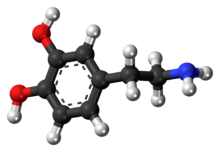Dopaminergic neuron
 |
|
 |
|
| IUPAC name | 4-(2-Aminoethyl)benzene-1,2-diol |
|---|---|
| Synonyms | 2-(3,4-Dihydroxyphenyl)ethylamine; 3,4-Dihydroxyphenethylamine; 3-hydroxytyramine; Intropin; Revivan; Oxytyramine; Prolactin inhibiting factor; Prolactin inhibiting hormone |
| Abbreviation | DA |
| Sources | substantia nigra; ventral tegmental area; many others |
| Targets | system-wide |
| Receptors | D1, D2, D3, D4, D5, TAAR1 |
| Agonists | Direct: apomorphine, bromocryptine Indirect: cocaine, amphetamines |
| Antagonists | neuroleptics, , domperidone |
| Precursor | Phenylalanine, Tyrosine, and L-DOPA |
| Synthesizing enzyme | DOPA decarboxylase |
| Metabolizing enzyme | MAO, COMT |
| Database links | |
| CAS Number |
51-61-6 |
| PubChem | CID: 681 |
| IUPHAR/BPS | 940 |
| DrugBank |
DB00988 |
| ChemSpider |
661 |
| KEGG |
C03758 |
Dopamine (contracted from 3,4-dihydroxyphenethylamine) is an organic chemical of the catecholamine and phenethylamine families that plays several important roles in the brain and body. It is an amine synthesized by removing a carboxyl group from a molecule of its precursor chemical L-DOPA, which is synthesized in the brain and kidneys. Dopamine is also synthesized in plants and most multicellular animals.
In the brain, dopamine functions as a neurotransmitter—a chemical released by neurons (nerve cells) to send signals to other nerve cells. The brain includes several distinct dopamine pathways, one of which plays a major role in reward-motivated behavior. Most types of rewards increase the level of dopamine in the brain, and many addictive drugs increase dopamine neuronal activity. Other brain dopamine pathways are involved in motor control and in controlling the release of various hormones. These pathways and cell groups form a dopamine system which is neuromodulatory.
Outside the central nervous system, dopamine functions primarily as a local chemical messenger. In blood vessels, it inhibits norepinephrine release and acts as a vasodilator (at normal concentrations); in the kidneys, it increases sodium excretion and urine output; in the pancreas, it reduces insulin production; in the digestive system, it reduces gastrointestinal motility and protects intestinal mucosa; and in the immune system, it reduces the activity of lymphocytes. With the exception of the blood vessels, dopamine in each of these peripheral systems is synthesized locally and exerts its effects near the cells that release it.
...
Wikipedia
